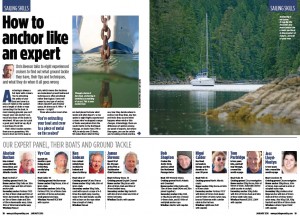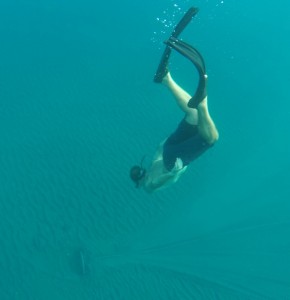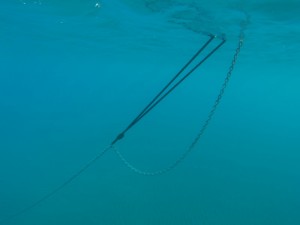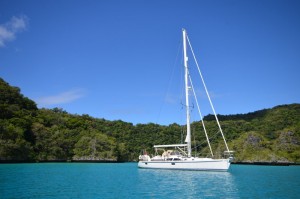‘Parking’ Adina
1Sunday 20 December 2015

Chris Beeson Yachting Monthly Jan 2016
Months back Chris Beeson at Yachting Monthly sent us a list of questions to answer about our experiences with anchoring. Chris has combined our answers with input from seven others and turned it into the article ‘How to anchor like an expert’ just published in the January 2016 edition of Yachting Monthly. And we have to give full credit to Chris (and certainly not us!) for publishing a top notch article, posing good questions and wrapping up the variety of views. It’s one of the best technical articles we’ve read in a long time – Chris has taken a well-oiled topic and made it a good read.
We spend ninety-nine percent of our time ‘at anchor’, as yachties like to call it. That means we rely on a heavy clump of metal with a pointed end and a whole load of chain to keep Adina, weighing twenty-one tonnes, safely in one spot while we sleep or go exploring for the day. Sounds dead simple – toss it over, job done. And frighteningly that’s literally what some people do. Many moons back in a crowded anchorage near Palma, Mallorca, Susie was swimming from Adina to the shore and back and she reckoned/estimated 75% of the boats’ anchors were simply lying on their side, not dug in. Fortunately the anchorage was well sheltered!
An ideal anchorage for us is one where the water is flat as a pancake and there is a gentle breeze to keep us cool and the pesky mosquitoes at bay. But it’s rarely like that. While wind is great for sailing, you don’t want too much of it while at anchor or you risk your anchor not sticking and ‘dragging’, a dreaded word in any yacht owner’s vocabulary. Dragging can mean worst case, ultimate horror story, you end up on shore with your boat damaged. Picture your place of abode not being secure – imagine waking up to find your bed is now in the Waitrose check-out area and there is utter chaos all around. Tins of Campbell’s soup all over your bedside table, Christmas brussel sprouts cover your head. But this is a reality we face; ok, we’re not going to end up in the Waitrose check-out area but we face a real risk of ending up on shore and our home being destroyed. Too horrible to think about – but think we must.
So step one you look at the weather forecast and pick somewhere that is sheltered from the wind and open sea. And guess what, that wind direction might change. Where we are in Malaysia right now it changes without fail within any twenty-four hour period – during the day it’s from the north-east and by evening time it’s swung south and then swings west. So you need to keep a constant eye on the weather and try to pick up on local effects. You also want to be out of the way of any swell from the sea, avoiding what we call rolly anchorages. Sleep doesn’t come easily on a rocking horse.

Checking the anchor 24 hours later just to be sure
Next you need to determine the bottom type – you need a bottom surface that your anchor can dig into and stay stuck. Hard rock is no good at all, thick mud will keep you there for days on end. In certain parts of the South Pacific lagoons are much favoured as they protect you from swell and waves but the coral is a real nuisance for the anchor. We all try to respect our environment so dropping a big heavy anchor onto coral is not nice, to a fish it’s a bit like a meteorite landing on your roof. Sand is our friend, the anchor digs in easily and it does a good job of holding. With mud you need patience, the thicker the mud the longer it takes to dig your anchor in but once it’s in you should be well set.
Knowing the anchorage should be good for the conditions we expect we also like to know the depth of the water we will aim to anchor in so we know how much chain to let out; the deeper the water, the more chain you need. Chain is good, it is extra weight on the bottom to hold you steady, so we aim to get lots of it down. On arrival we do a bit of a drive past to ensure the spot looks good, that it meets our expectations. Like people who live in houses on land, we too have neighbours. And in popular spots, there will be lots of neighbours. Boats don’t sit still, they move with the wind and tide and all boats will swing slightly differently to each other, so you need to consider what we call swinging room. In the Marquesas, French Polynesia, the small bay where you complete check-in formalities was very crowded and people had stern anchors out too, pointing themselves into the swell coming into the bay. When it gets crowded we’ll put fenders out; strangely we seem to be the only ones to do it. Yet we saw a yacht come unstuck while the owners were ashore and it drifted onto another yacht – guess what the other yacht got out to protect themselves? Fenders. What would have happened if neither yacht had anybody on board?
So, happy with where we have chosen to park Adina we slowly motor up to our desired spot, pointing into the wind or tide whichever is stronger. Then there’s anchoring technique. Drop it over and leave it, or take your time and sleep more peacefully. Sometimes we feel like idiots taking so long about it, others are already cracking open the gin when we may still be going, but no rush. You stop the boat, drop your anchor and if there’s a bit of wind, let it blow you back. Nice and slow. And communications here are all important. You can spot seasoned sailors – little talk, they use hand signals. These are all good except for the odd curse at both ends of the boat when Susie’s hand goes up-and-down and that means we’re dragging. Rats – do it again. Our worst ever was in Tonga on a coral bottom when it took ten attempts – and we only succeeded as we hooked onto, rather than into, something.

A ‘snubber’ helps take any shock
Once the boat stops reversing and the chain rises up it means the anchor has started to take hold. But hooked isn’t good enough, the anchor needs to be dug in deep. Time for the engine. Slowly but surely we increase the engine revs. Add revs, wait, check if the boat is moving/dragging. I look at transits on land that allow me to know if we are moving and cross reference with the boat’s instruments with their recorded track and speed over ground. That track is always on in case we need to beat a hasty retreat and follow our route back out. Susie has her foot on the chain feeling for vibrations, a sure indication we are dragging. Wait, let the anchor dig in, increase the revs. We’ll take them right up and I was impressed to read in Chris Besson’s article one of the panel said 30 seconds at 2500 rpm causes the anchor to set more deeply than Force 6 winds. If we both agree we’re happy, a final burst of revs and then we stop.
A snubber which consists of plaited rope then gets hooked onto the chain and its twin lines led back to cleats either side of the bow. The job of the snubber is to take the strain off the chain, it’s got elasticity and absorbs shocks. We leave our screen plotter on for at least 30 minutes so we can record a track and ensure we are not moving.
Then it’s time for a nice swim, and we take the snorkel and fins and physically check if the anchor is dug in. And it’s so much more fun in the Tuamotos when black tip sharks or a giant barracuda join you for the inspection. Of course that swim is pointless when it’s in the cold and murky waters of the Solent back home in England.
 No going ashore until we are happy we are secure and that can often mean only going ashore the next day. In fact if a blow comes through and we don’t move, it gives us faith. If conditions aren’t ideal and there is some sightseeing to be done we’ll tag up with another boat, taking turns to watch each other’s boat. And sometimes it does get nasty and you may have to do an anchor watch at night, which means staying awake, taking turns and watching the boat. An anchor alarm on a handheld GPS or phone can be put next to your bed to let you know if you do move.
No going ashore until we are happy we are secure and that can often mean only going ashore the next day. In fact if a blow comes through and we don’t move, it gives us faith. If conditions aren’t ideal and there is some sightseeing to be done we’ll tag up with another boat, taking turns to watch each other’s boat. And sometimes it does get nasty and you may have to do an anchor watch at night, which means staying awake, taking turns and watching the boat. An anchor alarm on a handheld GPS or phone can be put next to your bed to let you know if you do move.
It sounds a lot of work, but it isn’t really; it becomes second nature, a job that gets done. And at the end of the day it takes some beating knowing you’re in a beautiful spot on the water, the sun is shining down, a swim in turquoise water beckons and Adina is sitting happily, safely and securely.
Makes parking the car in the garage look simple doesn’t it?

Good stuff Tom/Suzie.I always thought the snubber protected the windlass from shock loadings and resultant wear?Are we seeing ye in Thailand for Xmas,the Albas thought ye might visit?
If not have a great Xmas and all the best for 2016